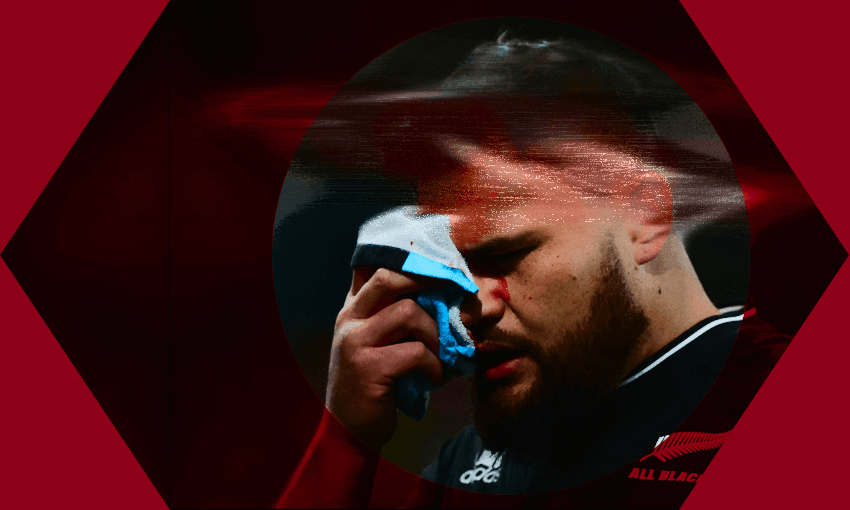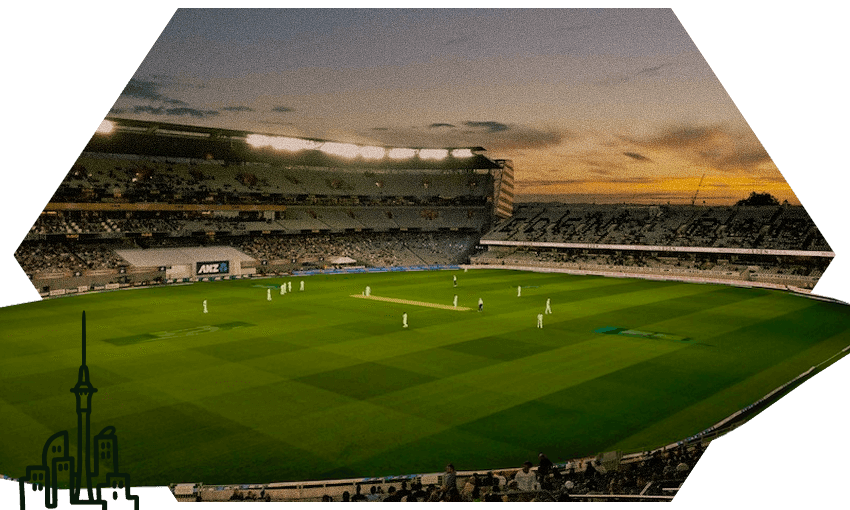More players than ever are suffering concussions through rugby. It’s tough for fans to watch – and much worse for the players themselves. So what’s the solution?
It was a test match full of big hits, heavy clashes, and sickening thuds. Or, as Grant Nisbett put it: “Ooof.” When Ireland scored against the All Blacks two minutes into last weekend’s second test, veteran midfielder Johnny Sexton set the tone by standing over prone All Black Aaron Smith, giving him an earful that was unlikely to be an invitation for a post-match croissant.
From there, the intensity escalated. At the 16-minute mark, airborne All Black winger Leicester Fainga’anuku was launched into the face of his Irish counterpart, Mack Hansen, smacking him square in the chin with his elbow and sending him sprawling to the floor. The crowd booed as Fainga’anuku was sinbinned. A second All Black, Ofa Tu’ungafasi, soon joined him thanks to an early tackle.
Down to 13 men, it’s what happened at the 30-minute mark that really hurt. With Ireland up 10-0, the All Blacks were desperate to hit back, but they couldn’t get their hands on the ball. During free play, prop Angus Ta’avao lined up Ireland No. 13 Garry Ringrose, attempted to tackle the ball carrier, mistimed his hit and ran straight into his face, using his own face as a buffer.
“That was nasty,” winced Nisbett as their cheeks and noses mashed together like playdough. Both lay stunned on the grass as the game stopped and match officials made a decision, using World Rugby’s safe tackling rules as a guideline, on what was clearly an accident. Red-carded, a dazed Ta’avao left the field with blood dripping down his chin. After the game, a 23-12 win to Ireland, a rugby-mad friend who’s just written a book about the sport messaged me this: “I hate rugby”.
Right now, many rugby players probably feel the same way. They’re nursing sore heads and spending weeks — or months — recovering from concussions. Ireland’s tour of Aotearoa has been marred from the start when a dazed Jeremy Loughman was allowed to continue playing despite this stumble against the Māori All Blacks. Johnny Sexton started last week’s game surrounded in concussion controversy, and All Black veteran Sam Whitelock was ruled out of last week’s game with concussion, but will return to play tonight.
It’s not just happening here. Three England players — Tom Curry, Sam Underhill and Maro Itoje — have been sent home early with concussions after a brutal test series in Australia. A recent study shows concussion rates in elite English rugby are at their highest rate since record-keeping began. In a recent NZ Herald column, Steve Deane compared rugby to the murderous Netflix series Squid Game, and opened with the incredible line: “The game that claims to be for everybody has become a game for nobody.”
Is this what rugby has come to?
“I find that part of the game grotesque,” says Dylan Cleaver. The celebrated sports journalist watched the second test against Ireland through gritted teeth, pondering this exact question. When Ta’avao face-mashed with Ringrose, he felt the impact from his couch. “That incident was horrible … you feel sick to the stomach. It’s gross.”
The problem? Rugby’s changed. The days of clever fullbacks and speedy wingers like Grant Fox and Christian Cullen controlling the game while beefy forwards protected them are long gone. Now, it’s all about brute strength. “Every player is 110 kilograms plus,” says Cleaver. “They span out across the field. It’s all about dominating and out-muscling the opposition.”
That crucial change started when rugby became a professional sport in 1995. Now, test matches are no longer about tactical innovation but survival of the fittest. “Rugby’s gone from a game of evasion to a game of collision,” says Cleaver. “There’s no space. It’s a battle for inches … space is at such a premium. It’s … a tough, tough game.” He’s seen it spread from top level sport down to schoolboy level, as coaches prepare teams to batter opposition into submission. “This style of rugby permeates all through the levels,” he says.
With so many powerful players clashing in the constant confrontations a rugby match demands, head knocks like Ta’avao and Ringrose have become an unwelcome but persistent part of the game. “Ta’avao is 125 kilograms and he had 4/5ths of a second to react,” says Cleaver, who studied the replays and doesn’t agree with the referee’s red card decision. “Sure, maybe his instinct could be to bend his knees and get lower, but that has to be coached into you right from when you’re very young.”
As unfair as Ta’avao’s red card seems, it’s one that sums up World Rugby’s problems. As awareness grows over the long-term impacts of consecutive concussions, and with a lawsuit from former players against World Rugby looming, Cleaver believes the international sporting body is attempting an impossible mission — trying to make “an unsafe game safe”.
That means it’s no fun for players, who receive yellow or red cards for accidental head clashes, and watch from the sidelines as sporting contests like last Saturday’s test become increasingly one-sided. It’s also no fun for fans. “It truly is damaging the spectacle,” says Cleaver. “I’m a huge proponent of making the game safer [but] if I pay $100 for a ticket to the rugby, I don’t want to see a farcical 15 v 13 test match.”
Cleaver isn’t sure the game can be saved, and says coaches have lost the art of innovation and instead train players for these gladiatorial contests. It’s even prevalent at schoolboy level. “I’m not sure how you put the cork back in the bottle,” he says. “There are elements of the game that are super hard to make safe. When your game’s based around … chasing and contesting high balls, every now and then the timing’s going to go wrong, you’re going to take someone out in the air, or guys are going to cut back against the grain into traffic. Like Angus Ta’avao, you’re going to get a head clash.
“I just don’t think you can change the game.”
“I really do struggle to watch these games,” says Dr Richard Seemann. The Auckland-based medical director, a specialist in rehabilitation medicine, says he can’t watch rugby games, and struggles with boxing or UFC matches. “I diagnose them from the TV set: ‘That guy looks like he might be concussed.'”
The problem, he says, is that even if all the rules of these sports are followed, head injuries are often the result. He points out that rugby players are much bigger and more powerful than they were 30 years ago. “They’re freaks of nature,” he says. “They’re trained to such a high degree. They’re building muscle mass. When they collide with someone, if they strike the head, it’s a concussive event for sure.”
Seemann sees the results of those impacts at his clinic ABI Rehabilitation, where he helps patients recover from head injuries. He’s dealt with rugby players who still have symptoms – headaches, dizziness, forgetfulness – despite not playing for a year. At that point, he tells them to retire. “You can’t send them back on the field because if they get another concussion they’ll be set right back again.” That’s the problem with concussions: no one gets better at recovering from them. “It doesn’t work like that,” says Seamann. Former All Blacks flanker Dillon Hunt quit after six years of professional rugby at the age of 26, telling NZ Herald his multiple concussions meant he couldn’t handle “any sort of noise or light”.
Cleaver has been covering the long-term impact of rugby’s head knock problems for years, most recently through his excellent newsletter The Bounce. He was the first to interview veteran All Black front rower Carl Hayman, who retired in 2015 but is already feeling the impacts of his playing days. Diagnosed with dementia at the age of 42, Hayman struggles to remember words and names, or even what he’s doing that day. “Once you accept your body’s screwed and you have no respect for it, you become an awesome player. Now I’m sort of paying the price a wee bit,” he recently told The Guardian.
Cleaver believes it’s not big knocks like Ta’avao’s that are the problem. Those players get pulled off the field immediately and given time out. “These players are incredibly well looked after and as a general rule they won’t come back to play until they’re recovered,” Cleaver says. Instead, it’s the smaller knocks – the knee in the head at the breakdown, the elbow in the face in a lineout, the ones whee players don’t get tested and rested – that cause most of the damage. “Rugby players mention it as ‘you get your bell rung a little bit but you carry on’,'” says Cleaver. “Those are the ones scientists are really worried about.”
Seemann agrees. The neurologist compares rugby to American football, where studies show players get dozens of potentially concussive head knocks in just one training session. The difference? Those players wear helmets. The rugby players Seemann deals with are aware of the issue and worry about the cumulative effects. “There’s a lot of anxiety of CTE (chronic traumatic encephalopathy),” he says. “If people aren’t recovered before a concussion and they have a second one, they’re much more likely to have extensive symptoms.” In extreme cases, a repeat incident can cause swelling on the brain, a potentially fatal issue.
Can rugby be saved? Seemann points to rule changes in ice hockey in 2012 that helped lower concussion rates without harming the game as proof that it is possible. But, like Cleaver, he says he hasn’t seen any indication of rugby officials wanting to make wholesale changes to the game. “When you look at the guys these days, they’re 100% brute strength and muscle ramming their heads at each other. It’s pretty hard to see that situation changing any day soon. [How do you] make a contact sport less of a contact sport?”





